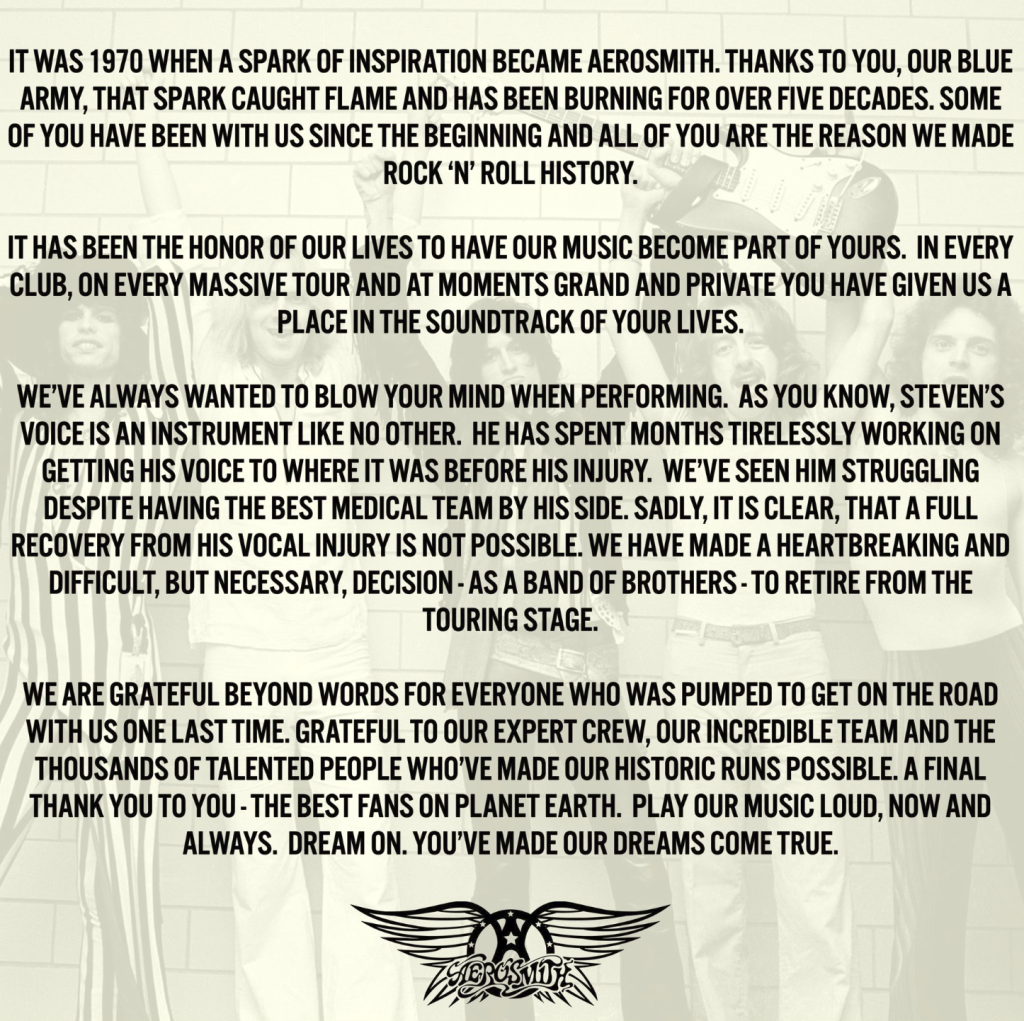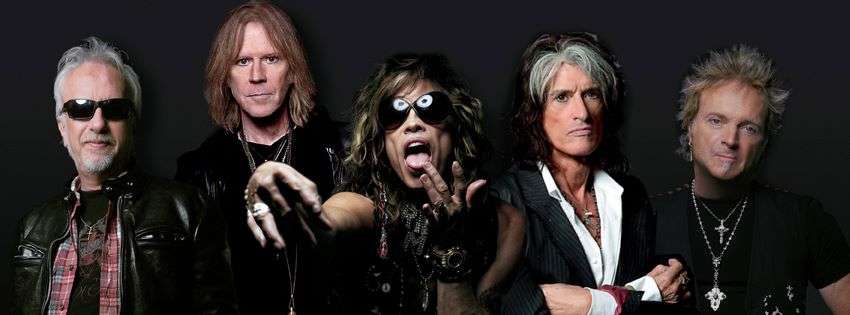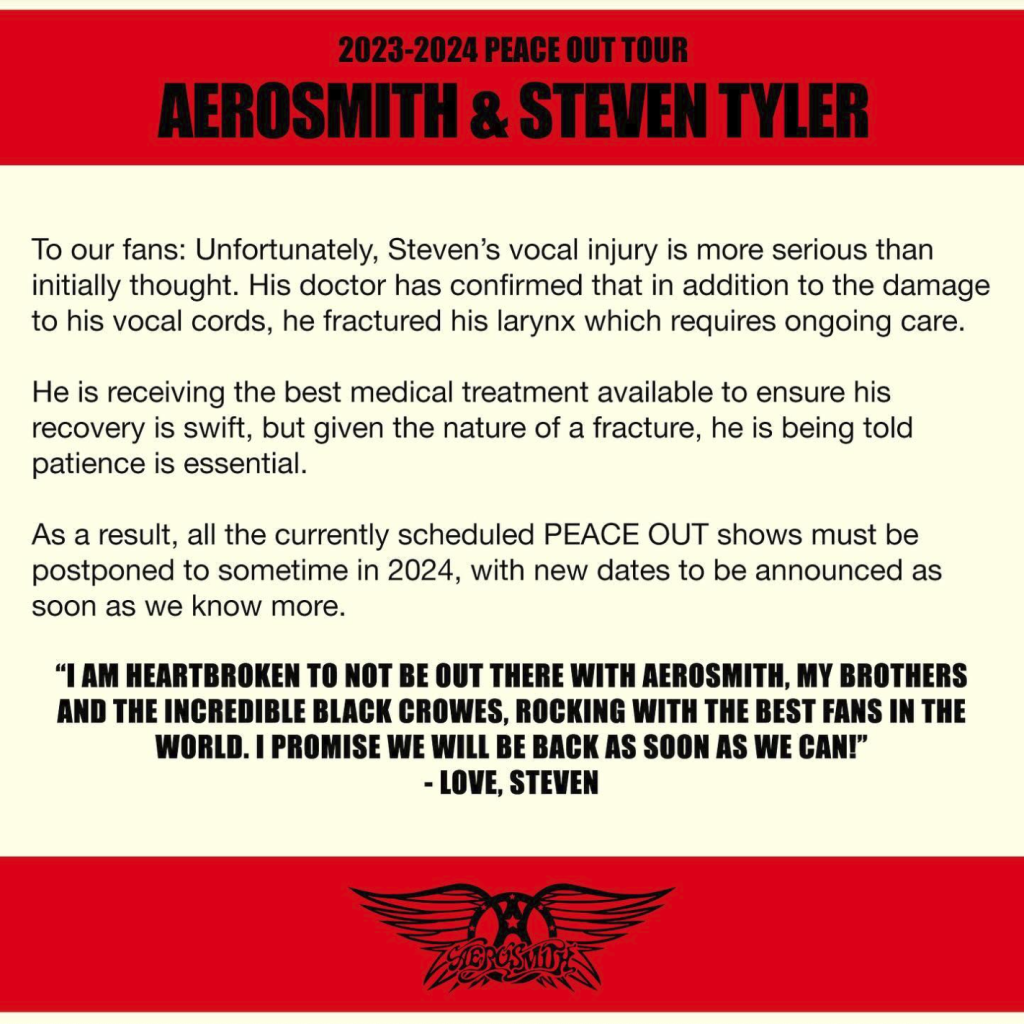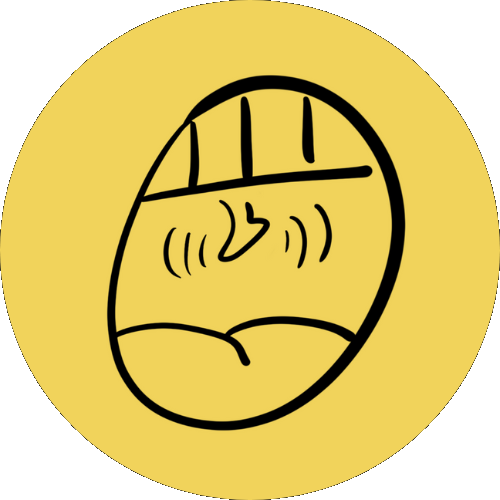As an affiliate for Amazon and SkillShare, I earn from qualifying purchases. This means that if you click on one of my affiliate links and make a purchase, I may earn a small commission at no additional cost to you. Thank you for supporting my work!
I still remember the day I listened to my first Aerosmith CD. I must have played “Get a Grip” on repeat, not because of the incredible guitar riffs or Tyler’s iconic vocals, but because of that hilarious burp at the beginning of the track. It was the little things that made me fall in love with Aerosmith’s music, and that memory has stuck with me ever since.
For Steven Tyler the stage was his kingdom, and his voice, the crown jewel. The legendary frontman of Aerosmith, has always been the epitome of rock ‘n’ roll—until the day his voice betrayed him. Tyler’s recent retirement due to a severe vocal injury shocked the world. After a lifetime of resilience, the voice that defined a generation has been silenced by a relentless injury. This is the story of a rock legend’s battle against physical and vocal injuries, and the lessons every singer can learn from his journey.
Aerosmith’s Most Recent Announcement
This time, the damage was severe enough to force Steven Tyler to retire from touring, marking a poignant end to a career that spanned decades. For a man who lived and breathed music, this must be a cruel twist of fate. Imagine the silence after the final note of the show, replaced by an unsettling awareness that something was wrong. Instead of the usual post-performance buzz, Tyler felt a haunting void where his voice had once been.

Official Announcement: Aerosmith’s Official Statement
“Sadly, it is clear, that a full recovery from his vocal injury is not possible. We have made a heartbreaking and difficult, but necessary, decision – as a band of brothers – to retire from the touring stage.”
– Aerosmith

A History of Injuries: A Story of Pain and Resilience
1980s: Motorcycle Accident and Knee Surgery
Imagine the 1980s—Aerosmith is on fire, and Steven Tyler is the heart of it all, living life as fast and hard as the music he creates. But then, out of nowhere, a motorcycle crash brings everything to a screeching halt. Tyler’s knee is shattered, and suddenly, the invincible rock star is lying in a hospital bed, facing surgery and a long, grueling recovery. For months, he was out of commission, focusing on physical therapy just to walk again, let alone perform. The accident wasn’t just a wake-up call; it was a harsh reminder that even rock gods can fall. It forced Tyler and Aerosmith to take a step back, at a time when the band was already dealing with its share of challenges. This was more than just a physical injury—it was a moment that blurred the line between Steven Tyler the myth and Steven Tyler the man.

1990s: Vocal Cord Surgery
Fast forward to the 90s. Tyler’s back in the studio, and things are going well—until, suddenly, he feels a pop in his throat. The room goes silent, and fear grips him. What had been a routine session turned into a nightmare. A ruptured blood vessel in his vocal cords required immediate surgery, and for a vocalist like Tyler, this was the ultimate scare. Imagine having to go completely silent for weeks, unable to speak, sing, or perform. That’s what Tyler had to endure. Aerosmith’s recording and touring schedules were put on hold, and the future of his voice—and career—hung in the balance. Thankfully, the surgery was successful, but the incident left a lasting mark on him, a stark reminder that his voice, the very thing that made him a legend, was incredibly fragile.

2000s: Throat Surgery and Broken Blood Vessels
Then, in 2006, during a high-energy performance—something Tyler was famous for—he suddenly felt something go wrong in his throat. A blood vessel had burst, right there on stage. He had to be rushed to the hospital for emergency throat surgery. The stage, once his sanctuary, had become a place of pain. This surgery wasn’t just about fixing a burst blood vessel; it was about making sure he could continue to sing. The recovery was tough—weeks of silence and vocal rest, with canceled tour dates and disappointed fans. It was a brutal reminder of the toll that decades of performing had taken on his body, particularly his voice. This injury underscored the ongoing battle Tyler faced to keep his voice in shape, even as the years piled on.

2009: Stage Fall and Broken Shoulder
Now, picture 2009. Tyler is performing live, as he always does—full of energy, giving the crowd everything he has. But then, in a split second, he loses his footing and falls off the stage. It was a terrifying moment, not just for him but for everyone watching. Tyler was airlifted to a hospital with a broken shoulder and head injuries. The fall wasn’t just a physical blow; it was a blow to his confidence, to the image of the untouchable rock star. Aerosmith had to cancel the rest of their tour, and Tyler had to undergo surgery followed by months of rehabilitation. The fall was a harsh reminder that even after decades on stage, the risks were still very real. Read more.

2010s: Foot Surgery and Ongoing Health Issues
The 2010s brought more challenges. Decades of performing had taken a serious toll on Tyler’s body, especially his feet. The constant jumping, running, and acrobatics had caused chronic pain, leading to surgery in 2011. This wasn’t just a simple fix—it required him to take a significant break from performing, with Aerosmith postponing tour dates. The recovery was slow and painful, involving intense physical therapy. This period forced Tyler to come to terms with the limitations of his aging body. He had to adapt his performances, reducing the physical intensity that had become his trademark. It was a sobering realization that even rock legends need to slow down.

2017: Recurring Health Issues
By 2017, Tyler’s voice had endured decades of powerful performances, and it was starting to show. During a South American tour, he began experiencing medical issues. The situation was so severe that he had to cancel the remaining tour dates and take an extended break. The recovery involved vocal rest and therapy, and it highlighted the ongoing challenges Tyler faced in maintaining his voice. It was a reminder that even the strongest voices need care and attention to endure.

2023: Fractured Larynx and Vocal Cord Damage
Then came 2023, perhaps the most challenging injury of his career. During Aerosmith’s “Peace Out” farewell tour, Tyler’s vocal cords suffered significant damage, leading to bleeding, and if that wasn’t enough, he was later diagnosed with a fractured larynx. This wasn’t just a minor setback—it required immediate medical attention, and Tyler was ordered to rest his voice for 30 days. The severity of the injury forced Aerosmith to postpone the rest of the tour to 2024 and ultimately led to the decision to retire from touring altogether. For Tyler, it was a devastating blow, but even in the face of this challenge, he remains hopeful about his future, holding on to the possibility of returning to the stage in some capacity. This injury was a stark reminder of the physical demands placed on rock vocalists, especially as they age, and underscored the critical importance of vocal health throughout a long career.
 |  |
See the Performance That Marked the End of an Era

Dr. Steven Zeitels: The Man Behind the Voice
Dr. Steven Zeitels has been a pivotal figure in Steven Tyler’s journey, working tirelessly to keep the singer’s voice alive through groundbreaking surgeries and innovative techniques.
The 5 Crucial Lessons Singers Can Learn from Steven Tyler
1. Your Voice is an Instrument—Treat It Like One
Your voice, just like any musical instrument, demands care, respect, and understanding. Steven Tyler’s journey reminds us that maintaining vocal health is paramount. This means knowing the mechanics of your voice and how to use it properly. Your voice isn’t just for singing; it’s an intricate instrument that requires proper technique, regular warm-ups, and continuous learning. Just as you wouldn’t neglect tuning a guitar, never neglect the daily care of your voice. This consistent attention ensures that your voice remains strong and flexible throughout your career.

2. Proper Rest and Exercise are Non-Negotiable—Listen to Your Body
Rest and exercise are the cornerstones of vocal health, and they are non-negotiable. Your voice is much like an athlete’s body—it needs to be exercised correctly and rested adequately. Listen to your body; rest when you need it, and don’t rush the process. But remember, rest alone isn’t enough—you must also exercise your voice properly. It’s not just about doing exercises; it’s about doing the right exercises in the right way. There’s a fine line between what’s right and what’s wrong. Just because something seems similar to the real thing doesn’t mean it is correct. Ensure that your exercises are aligned with professional guidance, so your voice remains in peak condition without risking injury.

3. Seek Help Early—Don’t Ignore the Warning Signs
Being in tune with your voice means recognizing when something feels off. Steven Tyler’s experience underscores the importance of seeking help at the first sign of trouble. Early intervention can be the difference between a temporary setback and a career-ending injury. If you notice strain, pain, or any changes in your vocal quality, consult a specialist immediately. Don’t wait for the problem to escalate; proactive care can save your voice and your career. Treat your voice like the valuable instrument it is—regular check-ups and early action are essential. Neglecting vocal health can lead to irreversible damage, as Tyler’s story so vividly illustrates. The pursuit of excellence should never come at the expense of your most valuable asset—your voice.

4. Adapt and Overcome—Embrace Change and Plan for the Future
As you age, it’s natural for your voice pitch to lower, and that’s perfectly fine. Rather than seeing this as a limitation, embrace it as part of your vocal journey. When songwriting, keep this in mind so that your songs remain easy and pleasant to perform as your voice evolves. Steven Tyler had to adapt his performances over the years, and so can you. Flexibility in your approach ensures longevity in your career. Adapting doesn’t mean compromising; it means finding new ways to deliver powerful performances that suit your voice’s current state.

5. Resilience is Everything—Persevere Through Challenges
Steven Tyler’s relentless pursuit of his passion, even in the face of numerous setbacks, is a lesson in resilience. Your journey as a singer will have its ups and downs, but it’s your ability to persevere that will define your success. Embrace challenges as opportunities for growth, and never stop fighting for your voice. Resilience isn’t just about surviving; it’s about thriving despite the obstacles. With determination, you can overcome anything that comes your way and continue to evolve as an artist.

What Steven Tyler’s Story Means for Singers
Steven Tyler’s story is not just one of personal struggle, but also of hope and inspiration for singers everywhere. His experiences highlight the crucial lesson of balancing the intensity of performances with the preservation of vocal health.
Every note, every scream, every performance comes at a price. Tyler’s decades-long career demonstrates that while passion can fuel greatness, it also requires careful attention to vocal care. For aspiring vocalists, the takeaway is clear: it’s not just about how loud you can sing or how high you can go—it’s about ensuring your voice lasts. Like any instrument, your voice needs to be maintained with care and respect to sustain its longevity.
For young singers, Tyler’s journey serves as a blueprint for success—showing both what to do and what to avoid. It’s about finding that delicate balance between pushing your limits and knowing when to pull back. By prioritizing vocal health from the start, you set the foundation for a long and successful career.
A vocal coach plays a vital role in this process, guiding singers in proper techniques and helping to avoid the pitfalls that Tyler encountered. With personalized advice, a coach ensures that your voice is used in the healthiest way possible, protecting your most valuable asset for years to come.

Was It Avoidable?
This is a question that sparks much debate among fans, vocal coaches, and medical professionals alike. While his relentless touring schedule and intense performances were undoubtedly factors, the reality is more complex.
Tyler is known for giving his all on stage, night after night. But could that very dedication have been his downfall? Was there a point when he could have pulled back, taken more breaks, or changed his technique to avoid such severe injuries? These are the questions that linger, but perhaps they also miss the point. Tyler’s career is defined by pushing the boundaries—physically, vocally, and artistically.

The reality is that Tyler’s injuries were likely a culmination of years of intense performance. Could different choices have been made? Possibly. But it’s also possible that these choices would have changed the very essence of what made Tyler and Aerosmith iconic.
My Opinion as a Vocal Coach:
As a vocal coach, I firmly believe that a lot of Steven Tyler’s vocal issues could have been mitigated with more strategic planning and a focus on vocal health. Early in his career, fewer performances coupled with intensive vocal coaching and strengthening exercises could have provided a stronger foundation for his voice. Additionally, lifestyle choices play a crucial role in vocal longevity. The demanding nature of rock ‘n’ roll, with its high-energy performances and associated lifestyle, undoubtedly took a toll on Tyler’s vocal cords. A more balanced approach—one that included adequate rest, proper hydration, and possibly a reduction in performance intensity—might have significantly preserved his vocal health over the years.
In the end, one of the hardest lessons for any performer is knowing when to step away. It’s easy to say that the best time to retire is when you’re at your peak, but that’s much harder to execute. For someone like Tyler, whose identity is so closely tied to his music and performances, recognizing that moment is incredibly challenging. However, it’s crucial for staying on top. While Tyler’s story is one of incredible resilience, it also serves as a reminder that strategic planning, proper technique, and knowing when to rest are essential for a long and healthy career in music.

Simple Ways to Detect Early Signs of Vocal Injury

My Top 3 Must-Reads for Serious Learners
The Vocal Athlete by Wendy D. LeBorgne and Marci Rosenberg
A comprehensive guide combining science and practical advice for maintaining vocal health. Ideal for singers and voice professionals, it offers exercises and techniques to prevent injury and enhance vocal endurance.
What Every Singer Needs to Know About the Body
A practical guide that teaches singers how body awareness and “Body Mapping” can improve vocal performance. It focuses on understanding anatomy to optimize posture, breathing, and technique while preventing injury. Ideal for maintaining vocal health and longevity.
The Owner’s Manual to the Voice by Rachael Gates
A user-friendly guide that covers vocal care, health, and performance tips. It breaks down complex vocal concepts into easy-to-understand advice, making it perfect for both professionals and those looking to improve their vocal health.

My Top 3 Recommended Singing Products
| Product | Description & Link |
| Vocalzone Throat Pastilles | These pastilles are especially useful for singers who experience throat irritation or strain. They contain a blend of natural ingredients that provide relief and support for your voice, making them a must-have for any vocalist. AMAZON |
| Bose SoundLink Revolve+ Bluetooth Speaker | Its portable design allows you to take it anywhere, and the high-quality audio ensures that you can hear every nuance of your practice tracks. Whether you’re rehearsing at home or on the go, this speaker will enhance your singing experience. AMAZON |
| Zoom H1n Portable Recorder | ideal for recording and analyzing your practice sessions. Its compact size and high-quality microphones capture clear audio, allowing you to review your performance with precision. Use it to track your progress, identify areas for improvement, and ensure you’re on the right path to vocal mastery. AMAZON |
The Final Note: A Resilient Rock Legend
Steven Tyler’s retirement due to vocal injuries is a sobering reminder of the importance of vocal health for anyone using their voice professionally. But his story is also one of hope. Tyler has faced adversity before—more than once—and each time, he’s come back stronger. Steven, if you ever read this, know that your strength and resilience have always been a beacon of hope for many. Your voice may be resting now, but your spirit and influence continue to resonate with fans around the world. Rock legends never truly fade away; they rise, again and again, inspiring the next generation to keep pushing forward, just like you have.
NEED HELP?
Unlock Your Vocal Potential
Let’s work together to unlock your full potential and make your voice shine. With personalized coaching and expert techniques, we’ll transform your singing. Join me and let’s make your voice unforgettable.

10. Frequently Asked Questions (FAQ)
Q: Can Steven Tyler’s vocal injuries heal completely?
A: According to the band and the recent official statements, a full recovery from Tyler’s vocal injury is not possible.
Q: What caused Steven Tyler’s vocal injuries?
A: Over decades, the intense strain from his powerful singing style, combined with multiple surgeries and other health issues, culminated in severe vocal damage.
Q: Can other singers avoid the kind of injuries Steven Tyler experienced?
A: Yes, with proper vocal techniques, regular rest, hydration, and early medical intervention, many vocal injuries can be prevented.
Q: Who treated Steven Tyler’s vocal injuries?
A: Dr. Steven Zeitels, a renowned laryngeal surgeon.
Q: What can singers learn from Steven Tyler’s experience?
A: The importance of vocal health, early intervention, and the necessity of balancing intense performance with proper rest and care.
Previous Posts


